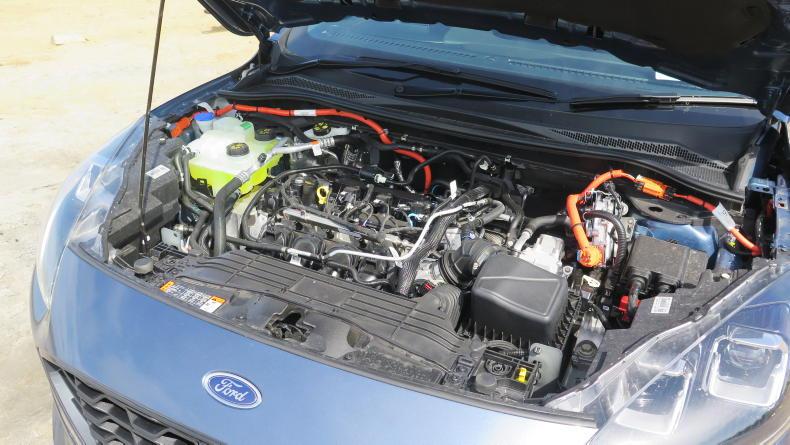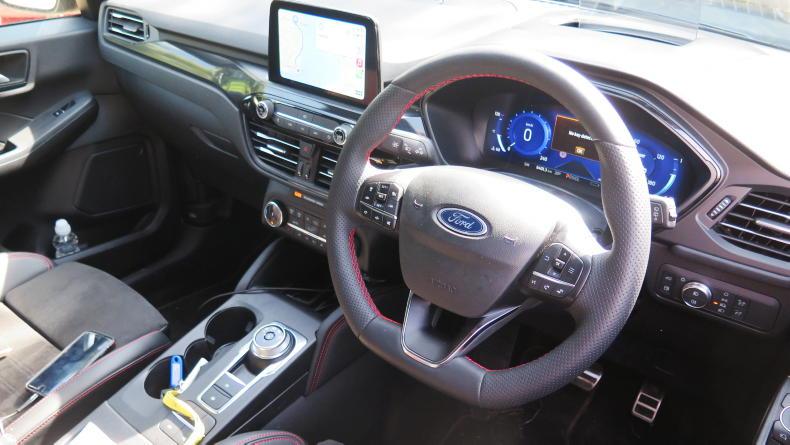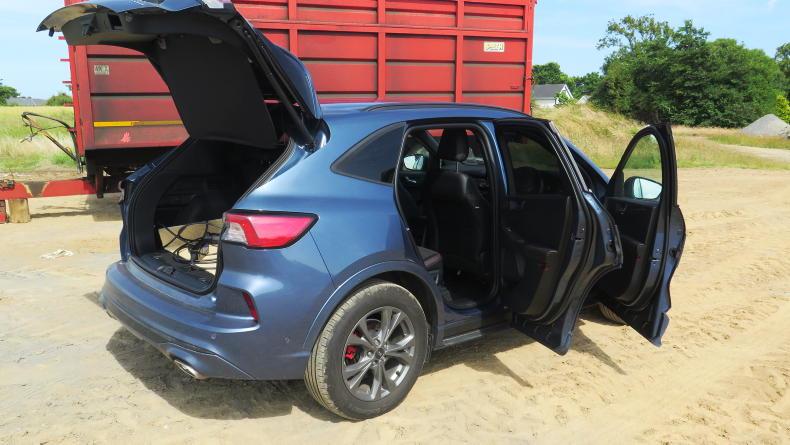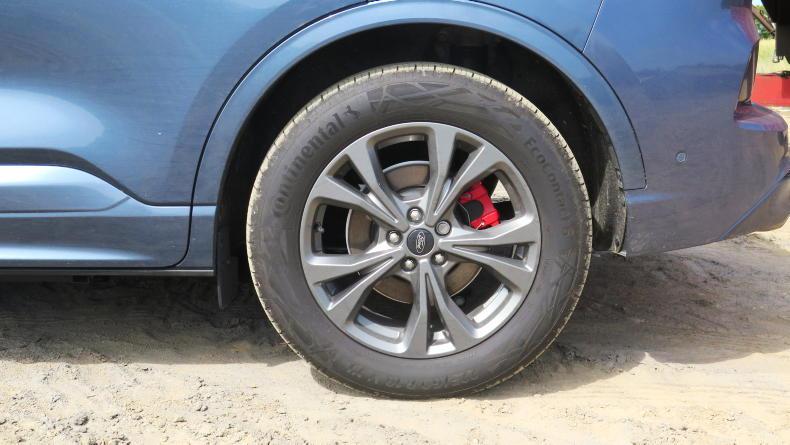Taking a car like Ford Kuga SUV for a longer-term test has been a game changer in terms of fuel economy, which is the real measure of a car’s value. What has changed is that compared with the most recent Kuga PHEV that I’ve driven (almost two years ago), this car can now achieve diesel engine levels of fuel economy.
Granted, I’ve been adopting a more economical driving stance, but I’ve noticed that I’m not alone. Increasingly, more and more drivers are sitting on the 100km/hr range on the motorways, helped by the more widespread use of cruise control systems. With that comes better fuel economy and a clear difference that’s noticeable in terms of car ownership costs.
That’s why this latest Ford Kuga was so impressive. I drove over 1,500km during my lengthy test, with comfort and not a hint of either range anxiety or fear of petrol pumps. This car delivers in value and ownership costs. I now see why it has been the best-selling SUV in PHEV form in Europe during 2022.
Most PHEVs have a relatively short range on electric power from your plug-in charging session and the Kuga is no different. The electric range is rated at 64km, which for rural drivers won’t bring you that far.

The Ford Kuga PHEV comes with a 2.5 litre petrol engine, matched to an automatic gearbox and hybrid drive system that delivers impressive regeneration ability to ensure an economical and smooth driving experience..
What’s really more impressive about the Kuga PHEV is the regeneration ability, where the car uses smart technology to constantly regenerate electricity when its 225bhp, 2.5l petrol engine is not needed. The move from petrol power to the electric power being constantly generated and stored in the 14.4kWh battery, is seamless and barely noticeable.
There is a neat display on the dash which shows you how it is performing and whether the car is driving in electric or engine mode. During my test drive of more than 1,500km, the Kuga was driving in electric mode for 38% of the time, so 594km of my drive was on electric power and I barely noticed it.
What I did notice was that this drive system delivered me a range of over 900km from the car’s 54l capacity fuel tank. That’s the bit that I’ll remember for a long time, not that any journey took me 15 minutes longer because I had modified my driving style for greater economy.

The dash layout of the Ford Kuga PHEV resembles that of the standard engine cars except for the useful dial that shows when the car is powered by engine or battery power..

The Ford Kuga SUV is a strong machine, with good entry from wide doors and a space-saver spare wheel in the boot.
The official Ford economy rating for the Kuga PHEV is 17.5km/l of petrol (5.7l/100km) and that real world figure was almost possible to match in Irish driving conditions. This is the first PHEV that has ever matched my expectations, so when it comes to the Kuga PHEV, I’m converted from diesel. I can’t say the same for other brands, just yet.
There are some downsides to the Kuga, mainly around towing ability for rural drivers. This model has a 1.5t towing rating, that’s 600kg less than the diesel equivalent.
The weight difference between this latest Kuga PHEV and its 2.0l turbo-diesel equivalent is now just 109kg, compared with over 300kg in the past, so the lighter more efficient battery has brought a huge bonus in terms of economy from non-electric driving.
Once I got over the success of the economy feeling, the other impressive features of the Kuga came into focus. The test car was the entry level ST-Line version, with a full body styling kit and 18-inch alloy wheels, matched with red brake calipers, and LED headlamps and front fog lights with front cornering features.

The Ford Kuga PHEV test car came running on Continental 225/60 R18 EcoContact 6 tyres, with little road noise except on the roughest surfaces.
Comfort is provided by a 12-way power adjustable front seats, while the B&O premium audio system with 10 speakers and subwoofer delivers impressive sound. Setting up the mobile phone was fast and easy with the Ford Sync 3 system, so I was quickly on the road with Apple CarPlay fully in place and a wireless charging pad to eliminate the need for charging cables.
This Kuga comes well equipped with safety features, even if it’s Euro NCAP safety rating is now a little dated. The car comes with a reversing camera, front and rear parking sensors, a pre-collision assist system with autonomous emergency braking, lane-keeping aid with lane-departure warning, and an intelligent speed assist system.
The boot space is a little compromised with battery systems. For good measure, however, there is a space-saver spare wheel in the boot.
Entry prices for the Ford Kuga PHEV start from €48,847, or £37,755 in Northern Ireland. I’ve looked at the three-year ownership costs for this car and they come impressively at about €0.38/km over a 60,000km use level. That’s cost-effective motoring in today’s world. They are a match for equivalent diesel economy figures and are also helped by Kuga’s good re-sale values that give a low depreciation figure, based on widely published car prices. So, the Kuga PHEV gets a solid thumbs up.
Taking a car like Ford Kuga SUV for a longer-term test has been a game changer in terms of fuel economy, which is the real measure of a car’s value. What has changed is that compared with the most recent Kuga PHEV that I’ve driven (almost two years ago), this car can now achieve diesel engine levels of fuel economy.
Granted, I’ve been adopting a more economical driving stance, but I’ve noticed that I’m not alone. Increasingly, more and more drivers are sitting on the 100km/hr range on the motorways, helped by the more widespread use of cruise control systems. With that comes better fuel economy and a clear difference that’s noticeable in terms of car ownership costs.
That’s why this latest Ford Kuga was so impressive. I drove over 1,500km during my lengthy test, with comfort and not a hint of either range anxiety or fear of petrol pumps. This car delivers in value and ownership costs. I now see why it has been the best-selling SUV in PHEV form in Europe during 2022.
Most PHEVs have a relatively short range on electric power from your plug-in charging session and the Kuga is no different. The electric range is rated at 64km, which for rural drivers won’t bring you that far.

The Ford Kuga PHEV comes with a 2.5 litre petrol engine, matched to an automatic gearbox and hybrid drive system that delivers impressive regeneration ability to ensure an economical and smooth driving experience..
What’s really more impressive about the Kuga PHEV is the regeneration ability, where the car uses smart technology to constantly regenerate electricity when its 225bhp, 2.5l petrol engine is not needed. The move from petrol power to the electric power being constantly generated and stored in the 14.4kWh battery, is seamless and barely noticeable.
There is a neat display on the dash which shows you how it is performing and whether the car is driving in electric or engine mode. During my test drive of more than 1,500km, the Kuga was driving in electric mode for 38% of the time, so 594km of my drive was on electric power and I barely noticed it.
What I did notice was that this drive system delivered me a range of over 900km from the car’s 54l capacity fuel tank. That’s the bit that I’ll remember for a long time, not that any journey took me 15 minutes longer because I had modified my driving style for greater economy.

The dash layout of the Ford Kuga PHEV resembles that of the standard engine cars except for the useful dial that shows when the car is powered by engine or battery power..

The Ford Kuga SUV is a strong machine, with good entry from wide doors and a space-saver spare wheel in the boot.
The official Ford economy rating for the Kuga PHEV is 17.5km/l of petrol (5.7l/100km) and that real world figure was almost possible to match in Irish driving conditions. This is the first PHEV that has ever matched my expectations, so when it comes to the Kuga PHEV, I’m converted from diesel. I can’t say the same for other brands, just yet.
There are some downsides to the Kuga, mainly around towing ability for rural drivers. This model has a 1.5t towing rating, that’s 600kg less than the diesel equivalent.
The weight difference between this latest Kuga PHEV and its 2.0l turbo-diesel equivalent is now just 109kg, compared with over 300kg in the past, so the lighter more efficient battery has brought a huge bonus in terms of economy from non-electric driving.
Once I got over the success of the economy feeling, the other impressive features of the Kuga came into focus. The test car was the entry level ST-Line version, with a full body styling kit and 18-inch alloy wheels, matched with red brake calipers, and LED headlamps and front fog lights with front cornering features.

The Ford Kuga PHEV test car came running on Continental 225/60 R18 EcoContact 6 tyres, with little road noise except on the roughest surfaces.
Comfort is provided by a 12-way power adjustable front seats, while the B&O premium audio system with 10 speakers and subwoofer delivers impressive sound. Setting up the mobile phone was fast and easy with the Ford Sync 3 system, so I was quickly on the road with Apple CarPlay fully in place and a wireless charging pad to eliminate the need for charging cables.
This Kuga comes well equipped with safety features, even if it’s Euro NCAP safety rating is now a little dated. The car comes with a reversing camera, front and rear parking sensors, a pre-collision assist system with autonomous emergency braking, lane-keeping aid with lane-departure warning, and an intelligent speed assist system.
The boot space is a little compromised with battery systems. For good measure, however, there is a space-saver spare wheel in the boot.
Entry prices for the Ford Kuga PHEV start from €48,847, or £37,755 in Northern Ireland. I’ve looked at the three-year ownership costs for this car and they come impressively at about €0.38/km over a 60,000km use level. That’s cost-effective motoring in today’s world. They are a match for equivalent diesel economy figures and are also helped by Kuga’s good re-sale values that give a low depreciation figure, based on widely published car prices. So, the Kuga PHEV gets a solid thumbs up.










 This is a subscriber-only article
This is a subscriber-only article










SHARING OPTIONS: